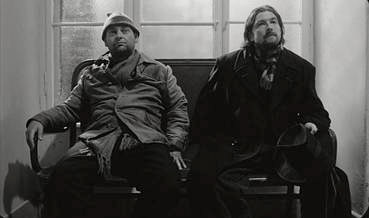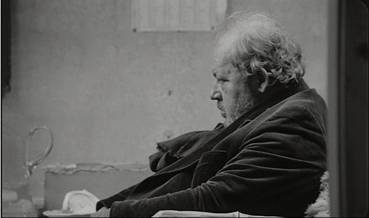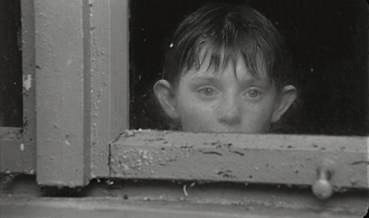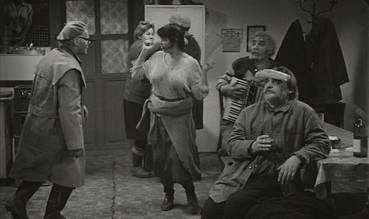|
If
your concept of Eastern European cinema involves films filled
with long silences, sombre conversations, bleak windswept
landscapes, grubby interiors and unhappy-looking peasant
types, then Sátántangó
will only serve to confirm your prejudices. It's loaded with
them. Oh, and it's in black and white, so the bleak looks
REALLY bleak. If you won't watch these films because you
expect them to move at a snail's pace and have long takes
in which nothing much happens, then you're really going to
have problems. Shots here can run for up to ten minutes
apiece, will often feature just one person doing one thing,
and will frequently be free of dialogue. Have I lost
you yet? No? Well try this on for size. It's seven hours
long. You heard me. That should whittle down the pack a
little. Still interested? Good. Now we can talk.
Sátántangó is set in a small
rural farming community in post-communist Hungary. The autumn
rains have begun and activity within the village has ground
to a virtual halt. Early one morning a church bell begins
to toll, even though there is no functioning church nearby,
and after the sun has risen, a figure wanders into shot
to investigate. At this stage we don't know who he is, where
he is, or even in this light what he looks like. By this
point we are just two shots and twelve minutes into the
film, and you soon realise that information is going to
be slow and often unclear in coming. Over the course of
the next ten minutes we discover that the man is named Futaki
and the woman he is with is not his wife but that of his
neighbour Schmidt, whose sudden arrival home sends Futaki
scurrying to the back room. We overhear that the community
has a sum of money and that Schmidt is planning to run away
with his share. We know little about the money itself or
its purpose, and just as we might be getting close to finding
out more, a new chapter begins. We're forty-one minutes
in by now, a third of the average feature film running time. Here
we've barely scratched the surface.
In
the second chapter, we are introduced to Irimiás and
his cohort Petrina as they walk down a wind-blown road towards
what at first seems like a hospital but is eventually revealed to be a government building, possibly a police station. Here, the two are grilled by an unnamed uniformed official and given a lecture on order, freedom
and collaboration. The
pair are humble and obliging, but once back outside they display a
more self-confident and authoritative swagger. Irimiás
is on his way back to the village, and when news of his
impending return reaches its inhabitants, apprehension spreads
like a virulent flu.

And
so it continues. There are twelve chapters in all, told
from differing viewpoints with overlapping narratives –
the story progresses in linear fashion, but the start of
a new chapter may move events back a few hours to replay
part of the previous chapter from a different angle. The
narrative itself is for some time ambiguous in structure
– halfway through I began to suspect I was now watching
events that occurred before those of the opening
scenes, a view I later had reason to reverse. Not that this necessarily
matters, as it becomes increasingly evident that storytelling
in anything approaching a traditional sense is not what
Sátántangó is all
about.
This
is perhaps most evident in the Chapter titled Know Something,
in which we watch the community doctor – an appalling example-setter
who drinks and smokes to excess and wheezes his way around
his house – as he observes and makes detailed notes on his
neighbours, falls flat on the floor and then recovers from
what we assume is a diabetic attack, then runs out of booze
and walks a considerable distance in the rain to get more. This sequence plays
out pretty much in real time, contributes only minor details
to the unfolding story, and is in absolutely no hurry
whatsoever. Thus when the doc nods off, we watch him sleep.
When he walks off into the gloom, we follow him the whole
way to his destination. This unblinking approach invites
us to observe him with the sort of unwavering concentration
and attention to small detail that we simply do not do in
real life. To what purpose? Ah, well...
Sátántangó
arrives on UK DVD having already been proclaimed in many
quarters since its 1994 release as a masterpiece, a label
the more critical viewer should consider it their duty to
be ready to challenge. It's strikingly photographed, rejects
formal storytelling techniques, and appears to be about very
little, but could, with the viewer's collaboration, be about
a great deal. It hails from Hungary rather than a more cinematically
populist region, and it's far longer than even the most
laborious western film, which will effectively dissuade
all but the dedicated from seeing it and contributing to
the discussion. But does that even make it good, let alone
a masterpiece? Doesn't that make it boring, pretentious
and self-important? Is the sense that there are more layers
of meaning than the surface suggests the result of the viewer
projecting their own, dreamed-up interpretation onto an
effectively blank canvas? It certainly looks meaningful,
so surely it must be. Mustn't it? I've just spent seven
hours of my life watching the bloody thing, so it must mean
something, surely!
Before I go on I should say that all of the above thoughts
did occur to me while I was watching Sátántangó.
There were moments in the first third where I began to sense that the Emperor's clothes were not quite as fine
as his courtiers were assuring him they were. But somewhere in the
first three hours of watching the film – I can't mark the
precise point because I don't think there was one – I found
myself strangely and completely hooked. Maybe it takes time
to adjust to the film's pace and fascination with still
moments, with the way it locks onto faces and asks us to
do likewise. It seems to want us to search for the story
behind that expression, behind what happened in the months
before Mrs, Schmidt came into the bar and sat down at the
table to stare off into nothing, her concentration only
broken by the need to investigate a smell coming from beneath
the table.

The
most remarkable example of this technique is also one that
almost sabotages itself. A young girl is tricked out of
what little money she has, and on returning home is ordered
by her mother to sit outside on a chair that has clearly been set up for
that very purpose. A short while later, she crawls into a barn
and we watch her wrestle and threaten a domestic cat, and
in her face and in her voice we see and hear the parental
indifference and verbal and physical abuse she has suffered
for years, together with the despair that is eroding her will to live.
It's a powerful and affecting scene, but the problem is
that the animal she is re-enacting her mistreatment on is
a real cat undergoing real abuse, and my sympathies for
the girl's predicament (which, let's be fair, is performed,
albeit with total conviction) ended up secondary to my concerns
for the animal she was pulling about. Thus, for a while the
scene becomes about the making of the scene, as I was dragged
out of the story and into the process of creating it. This
is made worse when she forces the animal to drink poisoned
milk and watches it die, something that certainly looks
very much for real, and handily provides a dead cat for
her to carry in the shots that follow. If you can deal with
this then you'll witness minimalist filmmaking at its most
troublingly effective, but it's likely to send animal lovers
reaching for the fast-forward button. It is this chapter
also that provides the most memorable narrative crossover
point, as the girl stops by a window to watch the haphazard
but exuberant dance taking place within, an event we later
witness from inside in its entirety in one long, slow-moving
and utterly compelling shot, interrupted only for a cutaway
of the girl looking in from outside, her despair and dislocation
from the other villagers painfully evident.
There
is the sense at times that we are being asked to look not
just at the content of a shot but its execution, to appreciate
its artistry of the filmmakers, and certainly there is a
great deal to admire here. Gábor Medvigy's black-and-white
cinematography is brimming with divine compositions and
beautifully executed camera moves, including stedicam work
so solid that you'll have trouble telling it from the on-the-rails
tracks. So many of the shots lodge hauntingly in the memory,
whether it be the long opening drift through the farm, a
slow and measured track up to a perched owl, or the impossibly
long circling of two policemen as they doctor and type up
a letter from Irimiás. There's barely a shot in
the entire film that does not leave you wide-eyed at the
care with which it has been planned and executed. Most compelling of all are the tracking shots that follow
or precede the characters as they walk, ride or, in a sudden
and almost jarring return to the modern world, drive. Even
though there is a peculiar artificiality to some of these
sequences – as characters walk down a furiously wind-blown
street and drive through the rain I was very aware of
the wind machine and hoses used to create the weather effects
– they are still so striking as imagery and effective in
their subtexual suggestion that they become storytelling
techniques in their own right. This is most pronounced when
we are moving backwards watching the faces of characters
as they move, with the young girl's long walk with her dead
cat once again proving the most haunting and emotive of
all.

These
sequences inevitably recall the 'walking movies' of late
era Alan Clarke and prefigure the more recent work of Gus
Van Sant, whose Elephant and Last
Days achieve a similarly hypnotic hold while
little is seemingly taking place. It would not be a stretch
to suggest a Tarkovsky influence either, although this is
more down to the look and feel than the storytelling technique. Sound
is also most effectively used (the strangely distorted church
bells and the hum in the café that so angers Irimiás
have an almost Lynchian quality to them), and combined with
the emotive visuals and some fine performances create a
treacle-thick atmosphere and sense of place that is increasingly
seductive, dragging you into a world of strangely logical
inactivity, where people wait for possible salvation at
the hands of a man they are prepared to believe in but still do not trust. It's with good reason, too – Irimiás
may have the Jesus beard, appear to have risen from the
dead, and be able to deliver a sermon of hope, but he represents
the darker side of the new capitalism and is poised like a vulture to feed
off the unwary.
So
does Sátántangó justify
its seven hour running time? Well in a way it does. If you
take a sixty minute story and present it in this manner
and at this pace, then it's going to take seven hours to
do so. But by telling this story at this speed and in this
way, director Béla Tarr so drastically alters the way we absorb
and interpret the supplied information that
time measurement is effectively altered for the viewer.
Despite long periods of seeming inactivity, the result is
never boring and is often mesmerising, and hard though this
may be for some to believe, it does not feel overlong. I'm
not sure I'm ready to go with the masterpiece label that
has been applied elsewhere, as for all its considerable
qualities I still can't help thinking that its messages
and meanings are a little too much in the eye of the beholder.
But it's still a bold, unique and gorgeously made film that
offers a very different viewing experience from the movie
norm, and that alone is to be enthusiastically applauded.
The
non-anamorphic transfer is framed approximately 1.68:1 and
is generally of a high quality, with detail very good and
contrast bang-on at best, although some scenes display a
narrower band of the greyscale where black levels are virtually
non-existent. Clean for the most part, there are a couple
of dust spots here and there, a not too intrusive scratch
on one shot and a little side light leakage on another.
On the whole, though, a decent job, though anamorphic would
have been nice.

The
Dolby 2.0 stereo soundtrack has no show-off separation,
but is crystal clear, particularly on sound effects such
as wind, rain and, erm, flies.
All
that's on offer here is a Béla Tarr filmography.
Although
it took me a while to synchronise with the film's pacing,
once there I found it a very comfortable and sometimes inspiring
place to be. In order to check something in this review,
just half-an-hour ago I put the first disc on again and
found myself instantly hooked, noticing small things I didn't
pick up on the first time around. There's no doubt that Sátántangó
presents a challenge for the viewer, but if you're up for
it then you're in for a film experience quite unlike any
other.
Artificial
Eye's 3-disc set lacks any notable extra features and it's
a shame that the picture is not anamorphically enhanced,
but for the most part serves the film well.
|